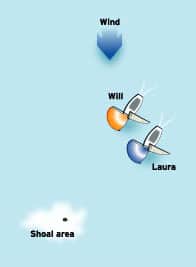
This month Ill answer some questions on the 2001 racing rules that have come up in seminars that Ive given to several fleets and clubs over the past few months.
Barging at the committee boat: Lou and Wendy are sailing closehauled on their final approach to the starboard end of the starting line as shown in the first diagram. They are overlapped on starboard tack with Lou to leeward. Several questions have been asked about this simple and common situation.
What rules apply if Lou luffs Wendy? First note that because the boats are approaching the starting line to start, Rule 18 does not apply (Rule 18.1(a)). Wendy is required to keep clear of Lou because she is the windward boat (Rule 11), but if Lou changes course he must give Wendy room to keep clear (Rule 16.1). If Lou luffs Wendy before she overlaps the committee boat, then Wendy will have plenty of room to keep clear. She can luff up and tack into the space behind and to starboard of the committee boat. However, if Lou luffs Wendy at the position shown in the diagram, there is no way that she can keep clear without hitting the committee boat. Lou is required to give her space to keep clear “in a seamanlike way” (Definition Room), and hitting the committee boat is decidedly unseamanlike. Therefore, Lou cannot luff if that would compel Wendy to hit the committee boat.
Suppose that theres a current setting both boats toward the committee boat, that neither of them changes course, and that Wendy is swept into contact with the port corner of the committee boats transom. What rules apply then? The new definition of a mark tells us that the entire committee boat is a mark, and so when Wendy touches it she breaks Rule 31. Lou holds his course, and so he does not break Rule 16.1. If he must bear off to avoid Wendy after she touches the mark, then Wendy would also break Rule 11. If Wendy breaks only Rule 31 her penalty is just a 360 degree turn. If she breaks Rule 31 and Rule 11, then her penalty is a 720 (Rule 44.4(a)).
Room to pass an obstruction: Will and Laura are overlapped broad reaching on starboard tack toward a shoal area marked by a tall thin pipe that is visible above the water. Both of them know this is a dangerous rocky area, as shown in the second diagram, into which they dare not sail. Before the boats reached the position shown in the second diagram Laura overtook Will close aboard from clear astern, and so she is not permitted to sail higher than her proper course (Rule 17.1). This situation can play out in four ways, and Ill consider the rules that apply in each.

Suppose both Will and Laura intend to bear off and pass the shoal to starboard. Obviously, the shoal is an obstruction, even though the pipe marking it is not. In this case the shoal is an obstruction that they both are “about to pass” on the same (starboard) side. Therefore, Laura must give Will room to pass the shoal (Rules 18.1 and 18.2(a)).
Suppose both Will and Laura think that the fastest course to the next mark is to pass the shoal to port. Then Rule 18.2(a) applies and requires Will to give Laura room to pass the shoal to port and, because Laura has right of way as the leeward boat, Will must also keep clear. What if Will protests Laura for breaking Rule 17.1 claiming that her luff to pass the shoal took her above her proper course? That protest should be disallowed because when Laura luffed to pass the shoal she was sailing her proper course — i.e., the course she would have sailed in the absence of Will to finish as soon as possible.
Now suppose Will hails for room to pass the shoal to starboard at the same time that Laura hails for room to pass it to port! In this case, the hails show that the boats do not intend to pass the shoal on the same side. However, because Will must keep clear of Laura, if Laura elects to pass the shoal to port, then Will would likely pass it to port as well. Therefore, even though Will would rather pass the shoal to starboard, the boats are about to pass it to port, and so the rules covering the situation are identical to the rules that governed the boats when both intended to pass the shoal to port.
Of course, if Laura decides to leave the shoal to starboard and Will elects to leave it to port, the rules are of no consequence because the boats courses diverge.
Note to Readers: I appreciate your many e-mails, and I hope youll continue to send your questions to rules@sailingworld .com. Time prevents me from answering all of them, but theyre useful in future columns and proposals to US SAILING to improve the rules. Unfortunately, I cant intercede on your behalf with protest or appeals committees.
Also, even though I am, again, the chair of the US SAILING Racing Rules Committee, the views I express here are solely my own interpretations of the rules. My columns aren’t official US SAILING interpretations. The only authoritative interpretations of the rules for U.S. sailors are the published US SAILING appeals and ISAF cases and umpire calls.
-D.R.









